How would the world of animation be different if instead of being a new tool the Web was an old one? Get ready for some pretty wild "classics." Martin "Dr. Toon" Goodman takes us theorizing...
(Note: The following is a fiction based on true events in animation history)
Time: 21 August 2000 @ 1330 / Content: Lesson Plan 4B/Estimated Run Time (incl. variable factor questions.answers) 61 min 40 sec. Image enhancement and vocoder: default settings. Initialize sequence 3YA 76C "Pixelle" bandwith 6768Hz/system is activated --
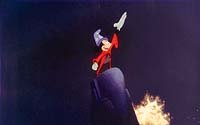
"Good afternoon, class. Today we continue with the early history of Internet animation and its impact on the societal and global perception of the animated medium. Please open your textbooks to page 17 and have yesterday's notes at hand. Simon Banetta, can you tell me where we left off?"
"Yes I can, Professor Pixelle. We were discussing the effects of World War I on computer development."
"Quite correct. In 1912, it will be recalled, the United States government discovered, and procured the services of, 12 year-old boy genius John V. Atanasoff. This prodigy, along with a talented staff, worked on an all-electronic computer for two years. With the outbreak of World War I the project was given special impetus under Secretary of War Baker during the Wilson Administration. Who can tell me the importance of this undertaking? Elena Diaz?"
"Well, if you're talking about the early development of computers, that's the period in which the first breakthroughs in magnetic-core memory and transistors replaced the first models that Atanasoff and Von Neumann designed. If you're talking about the Internet, that was the period in which Remington Rand started working on integrated communication networks for the military."
"Correct on both counts. Wilson, anticipating entry into WWI, gave the project top priority. Unfortunately, the modern computer and the Internet could not be developed in time to help the Allied war effort or make the world safe for democracy.' We were able to get no further than the concept of a stored program and the progenitors of languages such as FORTRAN and COBOL by the end of 1918. Still, this 24-hour a day, intensive research effort involving the most brilliant minds and prodigies from across America was one of the most impressive technological feats ever accomplished. The stage was set for the silicon disk in 1920, the semiconductor in 1923, and the first modern operating systems with ultra-large scale integration by 1926. By the time Mussolini controlled Italy and Communism was well-established in Russia, microprocessor technology allowed nearly every American to own a personal computer. This fueled one of the biggest economic booms in our history. Adam Curtis, perhaps you can tell what happened next."
"I can. The Department of Defense had ARPANET running by 1928, realizing Wilson's dream. Within two years, thanks to the discovery of TCP/IP by Vint Cerf I, we had the Internet by 1929. Of course, the first animation software had been used by then. I think it was, uh, Real-Izer, developed at the Fleischer studio in 1927."
"Everyone has done the assignment, I see! Right again. The combination of Internet-ready systems and animation software by 1930 turned a cel-based medium into one that could be downloaded worldwide through computer plug-in devices. Now, you mentioned the Fleischer studio; good starting point. Having long been fascinated by technical advancements, Max Fleischer was one of the first pioneers to take advantage of early CGI software. The Real-Izer was a decent start, but had many problems generating 3D effects. When Max hired Ub Iwerks away from the Disney studios in 1931, this gifted technician was able to refine the software until Real-Izer 4.5 overcame the technical problems involved in 3D rendering. Who can discuss the next great advancement in Web-based animation? Chad Wright?"
"In my opinion, professor, the next advancement wasn't technical at all. It had to do with the creator's rights battles of the 1930s."
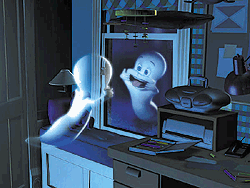
"An interesting assessment, Mr. Wright. Say more."
"Sure. After the Net developed into the World Wide Web, animators began independently developing cartoons in their own small studios. The movie moguls and film producers wanted their stuff, but were forced to deal with them on a contract basis. The first challenge to the system happened in 1932 when two independents, Joe Oriolo and Seymour Reit, were hired in at Paul Terry studios. While working there, they hit it big with a Web-based toon of their own called Casper the Jive-Jumpin' Ghost. Terry tried to claim that since Oriolo and Reit worked for him, Terry Studios automatically owned the rights. It took a court less than a month to decide in favor of the creators, and Oriolo and Reit wound up millionaires. After that, creators dealt with studios on their terms, and the suits were lucky to get 15% of any merchandising rights. That's got to be a major step, Professor Pixelle."
"True enough, and your point is well taken. Perhaps Lin Zhao can take the story from there."
"Gladly, prof. The first 3D Web cartoon was Ko-Ko's Diner, 1930. Fleischer and Walt Disney Studios were pretty much neck and neck through the early 30s, but it was the Fleischers that took advantage of the fact that the Web was not subject to regulation, and that literally any content could be broadcast without the threat of censorship. Max and Dave began to produce two sets of cartoons, one for public consumption in movie theaters, and another for the Fleischer Web site. Those that enjoyed more risqué, surreal, and in some cases graphic content could download the erotic adventures of Betty Boop. Disney chose not to go that route, believing that what Americans really wanted was clean, wholesome entertainment. His brother Roy urged Walt to go a more modern, adult-oriented route but Walt wouldn't play ball.
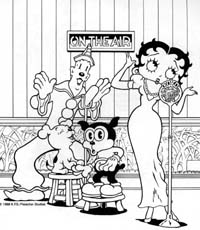
"By 1935, it was clear who had won that battle: the Fleischer Web site, with millions of hits and subscriptions, financed more advances in software and resulted in better theater-based cartoons for their studio as well. Disney tried to counter by unveiling Mortimer Mouse in 1933, but by the end of the decade this rather tame character was all but defunct. Disney's last gasp came in 1937 when he attempted the first feature-length animated feature Snow White and the Seven Dwarfs, but by then most of his key animators such as Norm Ferguson, Bill Tytla and Grim Natwick had already signed with Fleischer or were freelancing at MGM, Warners or Van Beuren. The film flopped, and the biggest hit of the year turned out to be the Web short Betty's Birthday Bash in which caricatures of the biggest male stars in Hollywood paid...um...tribute to Betty on her fourth anniversary as a star."

"Yes, and that brings us to today's lecture. Class, please turn to page 41. With the Fleischers established as the premier animation studio in America, a position they still hold today, a new trend began to take place. Fleischer and other studios such as Terry, MGM and Mesmer began to offer benefits packages and signing bonuses to independents in order to procure and keep their services. It was a difficult path for the studios; many of these highly eccentric, restlessly creative mavericks either chafed at being under a production system or would attempt to strike it big with an independently produced character they hoped would be their ticket to fame and riches. At times this worked: witness Jack Kinney's independent revival of a then-forgotten character named Goofy following the failure of the first Disney studio in 1940. At other times it failed, as with Isadore Klein's attempt to launch his Super Mouse -- later known as Mighty Mouse -- series after his departure from Terry Studios in 1941.
"The battles over creator's rights and studio properties never truly ended, however. One of the few mistakes Max Fleischer made was relinquishing the rights to a minor property. Dave Tendlar and Myron Waldman independently produced a Web-based cartoon named Popeye The Sailor that Fleischer had let go as part of a contract incentive for Waldman. The old sea dog's markedly violent and steamy adventures were soon the hit of the Web, and Max attempted to void the contract. His powerful legal department succeeded in shutting down Waldman and Tendlar's Web site until the decision was overturned in Appeals Court. At times the creators themselves were at odds, as happened after Bill Hanna and Joe Barbera created the highly successful Tom and Jerry series in 1940. Each claimed exclusive credit, and the situation was not helped when producer Fred Quimby, for reasons unknown, paid an exceedingly large bonus to Bill Hanna. The legal battle, highlighted by the infamous missing floppy disks' controversy, ended with Hanna and Barbera never again working with one another. However, no case was more convoluted than that of Bugs Bunny at the Warner Bros. studio.
"Independent producer Leon Schlesinger was, along with the Fleishers, the main beneficiary of the collapse of the first Disney Studio. Walt's refusal to market a wilder, more adult product for the World Wide Web sent former Disney animators such as Isadore "Friz" Freleng, Chuck Jones, Fred Moore and Milt Kahl over to Schlesinger's stable, and the crafty producer also signed such independents as Robert Clampett, Tex Avery, Frank Tashlin and Dick Huemer. After contracting with Warner Bros. for a distribution deal, Schlesinger turned the team loose for the first time in 1938. Clampett and Tashlin turned out to be natural partners, creating a risqué couple named Porky and Petunia Pig. The first cartoon in the series, Porky's Hot-Cha Honey, established the studio as a comer. Fred Moore's sensual 3D rendering contrasted brilliantly with Tashlin's rapidly paced direction and quick cuts, not to mention Clampett's twisted gags."
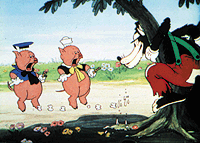
"What about the Jones-Avery-Kahl dispute, Professor?"
"Getting to it, Ms. Zhao. Friz Freleng, Chuck Jones and Milt Kahl came up with a rabbit named Bugs Bunny who at first appeared only in theater-based productions. It remained for Tex Avery to add the warped humor and tight pacing that made the hare the new darling of the studio's Web cartoons. Unfortunately, this led to a dispute over the actual ownership of the character, who existed in two distinct mediums. Jones claimed exclusive credit for the character's creation, a story disputed by Kahl, who claimed that he and Huemer developed a similar rabbit named Max at Disney. Jones' story was supported by Clampett, who stated that he was present at the early storyboard and wireframe design sessions before he and Tashlin left to work on Web cartoons featuring the very popular (and now discontinued) sexpot Coal Black. Avery, for his part, claimed that Bugs Bunny was his first effort at motion-capture and that he had the program to prove it. The debate between Avery and Jones developed rancorous overtones, and the two sadly remained at odds throughout their respectively brilliant careers. Avery eventually left studio work altogether and remained an independent until his death despite tempting offers from Walter Lantz and Otto Mesmer. We'll meet him again later in this course."
"Professor Pixelle, not to change the subject, but something's got me confused. Our e-lesson plan cites Fantasia as 'the greatest animated film that was never made.' I don't get it."
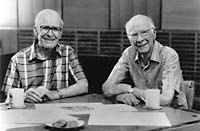
"Actually, Eric, that fits in with our next topic. Roy Disney was determined to stay in business despite his brother's abandonment of the field for a career in urban planning. Roy resurrected a discardedidea for a film called Fantasia that existed only as a seriesof notes from Walt. The film was intended to be an exercise in the higher arts; Roy believed that a market existed for adult cartoonsthat were sexy, yet more refined than the raucous, edgy and often violent products that were finding their way to America's PCs and laptops. In 1942 Roy Disney established the second Disney Studio and put the production of Fantasia in the hands of two loyalists left over from Walt's regime, Frank Thomas and Ollie Johnston. It was hoped that this lightly erotic film, set to classical music, would recapture audiences and that the characters would spin off to the subscription Web site.
"Under Thomas and Johnston the artistic renaissance known as 'Disney's New Wave' flourished, featuring artists and writers such as John Hubley, Dave Hilberman, Bill Hurtz and Steve Bosustow. They were soon joined by Chuck Jones who, tiring of rowdy cartoons and personality clashes, yearned for a more intellectual approach to animated shorts. This crew began to experiment with Fantasia, replacing classical music with jazz and finally breaking the segments up into convenient downloads. The most famous segment was, of course, 'Rooty Toot Toot.' Though Roy Disney's Fantasia was ultimately never made, the 'New Wave' ended up redesigning the entire look of Web cartoons by minimizing 3D sequences, eschewing special effects and abandoning attempts at motion-capture. These simple but stylish cartoons created a stir among the artistic community and had the added advantage of a fast download time."
"Thanks, prof! I got it!"
"This will be our stopping point for today. Next week we will examine how World War II affected the World Wide Web and how the Internet became a powerful tool for animated propaganda on both sides. The effect of the 'Tokio Jokio' virus as a weapon will be examined, and we will also see how government blackouts, firewalls, and discontinuation of local servers in the name of national security affected the history of animation. Your assignment is to read pages 65-98, including the section 'Hitler's Hackers.' Class is dismissed, and have a pleasant afternoon."
Time: 21 August 2000 @1431/ Initiating shutdown sequence 3YB for hologram "Pixelle." Save image enhacement pathways and vocoder defaults. Deactivation table 4.009 in progress 5..4..3..2..1..end program.
This column marks my first full year with Animation World Magazine! I would like to thank my very first editor, Michelle Klein-Hass of the late, lamented Animation Nerd's Paradise Web site for helping me to find a home here, and also Dan Sarto and Heather Kenyon of AWN for hosting me and allowing me to lend my voice to the animation community. Lastly, thanks to my readers, whose support, comments and cogent emails have been a joy to me over the past year. Thanks, one and all!
Martin "Dr. Toon" Goodman is a longtime student and fan of animation. He lives in Anderson, Indiana.







